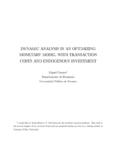Dynamic analysis in an optimizing monetary model with transaction costs and endogenous investment

Ver/
Fecha
2001Autor
Versión
Acceso abierto / Sarbide irekia
Tipo
Documento de trabajo / Lan gaiak
Impacto
|
|
nodoi-noplumx
|
Resumen
This paper analyzes the period-to-period changes that occur in an optimizing monetary model with uncertainty and sticky prices. Money is incorporate in its role as a medium of exchange through a time-cost transactions technology. Another important characteristic of the model is that both capital and investment are obtained endogenously. In this regard, adjustment costs of installing investment ar ...
[++]
This paper analyzes the period-to-period changes that occur in an optimizing monetary model with uncertainty and sticky prices. Money is incorporate in its role as a medium of exchange through a time-cost transactions technology. Another important characteristic of the model is that both capital and investment are obtained endogenously. In this regard, adjustment costs of installing investment are incorporated to smooth and delay capital movements over the economic cycle. We will focus attention on analyzing the consumption, investment and real money demand functions resulting from the model. These three equations give rise to the structural IS-LM economy as part of the general equilibrium described in the paper. Nominal prices are sticky, i.e., they do not adjust instantly thereby allowing departures from general equilibrium obtained when there is absence of nominal frictions. We chose to have the Fuhrer-Moore specification for nominal contract prices. The model is calibrated on quarterly observations from United States data. Four types of exogenous shocks are included in our setup: production technology shocks, consumption preference (demand) shocks, monetary policy shocks, and shopping time shocks. Hence, variability of output, consumption, investment, etc., may result from several sources. The impact of each shock in the economic cycle will be examined by plotting impulse-response functions implied by the solutions of the model. [--]
Materias
Money,
Dynamic optimizing models,
Business cycle
Serie
Documentos de Trabajo DE - ES Lan Gaiak /
0108
Departamento
Universidad Pública de Navarra. Departamento de Economía /
Nafarroako Unibertsitate Publikoa. Ekonomia Saila





